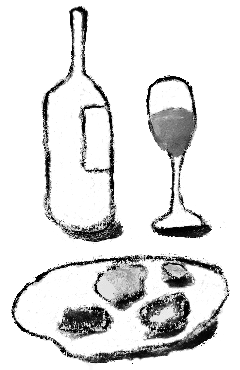
The opportunity to drink a wine where it is produced always seems special to me. It’s like eating fruit right after picking it from the tree. In the case of a wine, drinking it where it is produced gives you the feeling of being part of its history, even if only on an imaginary level. Port wine is a case in point. Drinking port on the banks of the Douro is different from drinking port anywhere else.
Wine production in Portugal dates back to Roman times. Wine production in the Alto Douro is more recent. Port wine, classified as a fortified wine, can be produced from a variety of grapes, although the most common are Touriga Nacional, Tinta Roriz, Touriga Franca, Tinta Cão and Tinta Barroca.
The history of this wine is marked above all by the political alliances and commercial relations between Portugal and England, the main importer of Portuguese wines since the 14th century. The commercial partnership between these countries resulted mainly from the sanctions imposed on France by England as a result of the European wars, including the one fought between the two countries, which became known as the longest in history: the Hundred Years’ War.
The expansion of vineyards in the Alto Douro occurred mainly as a result of the popularity of Port wine in England during the 18th and 19th centuries. In the mid-18th century, most of the wine imported into England came from Portugal. A large portion of this wine was already supplied by the Douro Valley.
At the time, the quality of the wines suffered greatly, partly due to widespread adulteration. Because of this, cognac was added to the barrels before they were sent to England in order to preserve the wine. Concern about the quality of the region’s wines also led to the Douro Valley becoming the world’s first Controlled Designation of Origin in 1756.

In the city of Porto, close to the banks of the Douro, on the opposite bank of the river, in Vila Nova de Gaia, you can already see the signs of the large winery warehouses, where English merchants have left their wines to mature in barrels since the 18th century. A bridge, which can be crossed on foot, separates the two cities. When you cross it, you can visit some of the wineries and do tastings.
You can also choose to sit in one of the bars on the banks of the Douro, in Vila Nova de Gaia, and contemplate the landscape of the river, the city of Porto and the imagery of the past over a glass of Port wine. After all, the past is always imagined.
Vinho do Porto, o Douro e suas histórias
A oportunidade de beber um vinho onde ele é produzido me parece sempre algo especial. É como comer uma fruta logo após colhê-la ao pé da árvore. No caso de um vinho, bebendo onde ele é produzido podemos ter a sensação de fazer parte da sua história, ainda que num plano imaginário. O vinho do Porto é um exemplo. Beber um porto às margens do Douro é diferente de beber um porto em qualquer outro lugar.
A produção vitivinícola em Portugal remonta a época romana. Já a produção de vinhos do Alto Douro é mais recente. O vinho do porto, classificado como vinho fortificado, pode ser produzido a partir de diversas uvas, embora as mais referenciadas sejam a Touriga Nacional, Tinta Roriz, Touriga Franca, Tinta Cão e a Tinta Barroca.
A história desse vinho é demarcada sobretudo pelas alianças políticas e relações comerciais entre Portugal e Inglaterra, principal país importador dos vinhos portugueses desde o século 14. A parceria comercial entre esses países resultou principalmente das sanções impostas à França pela Inglaterra, em razão das guerras europeias, entre elas, aquela travada entre ambos os países, que ficou conhecida como a mais longa da história: a Guerra dos Cem Anos.
A expansão das videiras no Alto Douro ocorreu sobretudo em consequência da popularidade do vinho do Porto na Inglaterra durante os séculos 18 e 19. Em meados do século 18, a maior parte do vinho importado para a Inglaterra vinha de Portugal. Uma parcela grande desse vinho já era fornecida pelo vale do Douro.
À época, a qualidade dos vinhos era bastante afetada, em parte, devido à adulteração generalizada. Em razão disso, antes de serem enviados para a Inglaterra, adicionava-se conhaque aos barris com objetivo de se preservar o vinho. A preocupação com a qualidade dos vinhos dessa região também fez com que no ano de 1756 o Vale do Douro tenha se tornado a primeira Denominação de Origem Controlada do mundo.
Na cidade do Porto, próximo às margens do Douro, já se pode avistar na margem oposta do rio, em Vila Nova de Gaia, os letreiros dos grandes armazéns das vinícolas, onde mercadores ingleses deixavam os vinhos para maturar em barricas desde o século 18. Uma ponte, que pode ser cruzada a pé, separa as duas cidades. Ao atravessá-la, é possível conhecer alguns desses empreendimentos e fazer degustações.
Pode-se também optar por sentar em um dos bares à beira do Douro, em Vila Nova de Gaia, e contemplar a paisagem do rio, a da cidade do Porto e dar vazão a imaginários do passado saboreando uma taça de vinho do Porto. Afinal, o passado é algo sempre imaginado.
